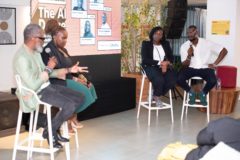It has long been predicted that artificial intelligence (AI) will trend this year, with companies across the world using this emerging technology in various ways to make their businesses more efficient. ChatGPT’s entry into the field of mainstream technology is shining an even brighter spotlight on AI, with many people and businesses looking to adopt this popular tool and other specialist AI programmes. But what is a viable way of applying tried-and-tested, specialist AI tools in your business or experimenting with ChatGPT as a professional?
Alex Pryor, Head of Digital Innovation at EOH, Neil van Wyngaard, solution architect at iOCO Digital, a proudly EOH company, and Nicole Adriaans, business executive: data and analytics at iOCO, provide some insight and practical examples.
Alex Pryor: ChatGPT continues to make headlines because it is the first mass adoption of an AI technology driven by a natural language processing (NLP) engine. The platform has had the quickest uptake by 100 million users compared to other new AI technologies. ChatGPT brings AI to individuals across society, whereas we previously needed corporate investment to take advantage of machine learning technology.
ChatGPT can be very useful, but because it has been trained on the internet and not only on reviewed sources like Wikipedia and scientific articles, you also currently need to verify all the information it provides you with. However, it becomes very useful when you integrate your application programme interfaces with ChatGPT. For example, you take the NLP engine, and you train it on a very specific data set, like a Governance Risk and Compliance (GRC) data set.
Since the public launch of ChatGPT, Open AI has launched GPT4, which is described as a powerful general, multi-modal technology. Google and a host of other tech giants and start-ups are also making substantial investments in AI tools. This strengthens the view that the next version of ChatGPT or Open AI will be capable of doing a lot more, much faster, and more accurately.
Business applications of ChatGPT
At this point, ChatGPT can be applied in the workplace to improve productivity. For example, a marketer writing an article could use it to brainstorm ideas on a topic and quickly gather information for an interesting piece. They could engineer their prompts so that the tool gives them unique ways to generate content and even suggests writing styles and formats.
Businesses can use ChatGPT alongside automation to conduct repetitive casework more smartly and productively. While Microsoft is incorporating AI into Teams to enhance features like minute-taking, AI can be added to chatbots to make them a lot smarter, if they are trained on the correct data sets.
What’s exciting about this type of generative AI is that it leverages AI algorithms that enable the use of existing content like text, audio files and images to create new, plausible content. It allows computers to abstract the underlying pattern related to the input and use that to generate similar content.
Businesses considering using ChatGPT, or any emerging technology, must understand its pros and cons. When using ChatGPT, the best approach is to pick one use case in a business and try it out. But it’s not a good idea to put anything mission-critical on it for now. It must be deployed where a business has manual, repetitive tasks, and be injected into creative spaces to support the work, but not to take over any processes. The result might be that some tasks are completed faster than they used to be.
ChatGPT has brought the possibilities of AI into the public arena and fired up the imagination of many. It offers us the opportunity to do the manual and repetitive tasks associated with business far more quickly, saving costs and improving efficiencies. However, ChatGPT is just one technology in a vast pool of available AI resources, and specialist AI models and programmes must be used for specialist tasks and industries.
Neil van Wyngaard:
Efficient execution of repetitive tasks
Specialist AI can be applied in the business world where people are doing repetitive tasks that have clearly defined rules. A good example of how specialist AI is being used to benefit local financial institutions is a “document-understanding solution”, one EOH has developed for a bank and home loan lender. This AI tool quickly and efficiently compares the personal and income information that loan applicants supply to the institutions with the data on their various verification documents. It highlights any discrepancies between the two sets of information, makes the necessary corrections and even identifies potential cases of fraud.
The AI automation tool makes the processing and verification of the applicants’ information extremely efficient – it evaluates a single application in seconds while the manual processing of applications could
involve a team of 40 people who process several applications over a few days. The obvious benefit of the tool is that it enables organisations to complete a much higher volume of transactions per day.
ALSO READ: ChatGPT won’t take my job but it might take my therapist’s
Businesses across retail, financial, manufacturing and other sectors are increasingly adopting AI automation tools such as procure-to-pay, an EOH solution that manages the process of receiving and processing vendor invoices from start to end. We have built bots that pick up emails with invoices, open up the accounting system, and process invoices. The system is proving very popular, with companies across sectors showing more and more interest.
Businesses that want to experiment with AI or use it to solve a business problem must first establish if there is an existing AI tool on the market that could address their needs. In a greenfield scenario where a company wants to build its own AI, they could make the investment worthwhile by selling it to other organisations.
Generic AI versus specialist AI
A generic AI tool like ChatGPT that is open to different data sets is unlikely to add value to specialist business areas. This is because an AI application (with a specific data set) has to run in the context of a specific area, task or challenge to be effective. Simply put, where you have a specific objective, the AI tool must be built for this purpose to be meaningful.
The reason there are so many different AI companies is that each company focuses on a niche area and has its own machine learning models and data sets that are not shared with others. So there won’t be one ChatGPT or AI tool that will answer every question.
Nicole Adriaans:
Precursors to ChatGPT and AI
The precursor to AI tools, namely advanced predictive analytics, has been applied by businesses for decades. Traditional advanced predictive analytics was the natural evolution of the descriptive analytics that businesses had in the form of their business intelligence and dashboards. For example, the banking sector has been running predictive analytic models for a long time, but it has been running it on the Statistical Analysis System. The difference now is that machine learning technology makes the process much faster.
Application in banking and retail sectors
Almost any sector could put NLP technology to good use. Retailers typically use specialist AI tools to customise their offerings to customers. Because AI allows them to glean a lot more information about individual customers, they can offer them products and deals that would appeal to them the most. AI helps the retail sector to retain its customers and build customer loyalty.
A popular application of specialist AI in the retail sector is call centre optimisation: an NLP engine can read the sentiment in a caller’s voice and smartly reverts calls to senior staff members when it deals with an irate customer. The result is that issues are de-risked or de-escalated.
In the banking sector, specialist AI is deployed to help prevent and detect fraud. Network analytics that identifies connections between customers based on internal and external data enable banks to establish who is connected to someone with fraudulent behaviour and allow the institutions to put more financial controls in place. Banks are also applying data science in a smart way in the field of agricultural lending.
Some industries in South Africa are excelling in the adoption of AI. The challenge is the proliferation of AI in communities and the public sector. State enterprises and departments need to use it; we need to get the country up to the point where all sectors trust and buy into it.
Alex Pryor is a seasoned technology executive. She is Head of Digital Innovation at EOH – one of Africa’s largest IT companies – where she focuses on identifying and implementing emerging technologies that drive business growth and value. Alex speaks regularly at industry conferences, where she shares her expertise on topics such as emerging technology, blockchain, innovation, and women in leadership.
Neil van Wyngaard is an experienced solution architect at iOCO Digital, a proudly EOH company. He is an accomplished engineering professional with a proven track record in the information technology and services industry. Neil has a passion for education and helping others to grow professionally.
Nicole Adriaans is the Business Executive for Data and Analytics at iOCO, a proudly EOH company. She has successfully led the design and implementation of data and analytics solutions across the business value chain from omni-channel to omni-digital initiatives since 2009. Nicole is devoted to empowering women in the tech industry.


















